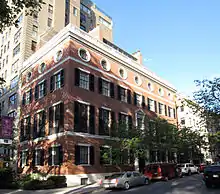Willard D. Straight House
The Willard D. Straight House was the New York City residence of Willard Dickerman Straight. The mansion is located at 1130 Fifth Avenue at East 94th Street on the northeast corner. It is located in the Carnegie Hill neighborhood on the section of Fifth Avenue known as Museum Mile and is one of only three houses remaining on Fifth Avenue in single-family occupancy, 925 and 973 Fifth Avenue, near 74th and 79th Street, respectively.

History

The house was designed by the firm of Delano & Aldrich in the neo-Georgian style and was completed in 1915. The ground floor of the house is organized around a circular hallway in the 18th-century style topped by a dome, with a patterned black and white marble floor.[1] The Straight family also owned a complementary building at 162 East 92nd Street, also designed by Delano & Aldrich, that was used as a garage. The second and third floors of this building contained apartments for staff.[2] Straight died during the influenza epidemic of 1918 and his widow Dorothy Whitney Straight continued to live in the house for several years with her children. She remarried and moved to England but continued to own the house until 1927.[1]
The house was sold to Judge Elbert H. Gary, Chairman of the Board of Directors of the United States Steel Corporation (who had recently sold his home at 956 Fifth Avenue which was demolished to make way for a new apartment building),[3] who died in the house the same year.[4] The next owner was Harrison Williams, a utilities investor, and his wife Mona.[1]
In 1952, the house was sold to the Audubon Society for use as their headquarters, which they called the Audubon House.[5] The Society left in 1971 and, in 1974, the building was sold to the International Center of Photography for use as a new museum devoted exclusively to photography with photo‐journalist Cornell Capa as executive director.[6] In 2000, as ICP was consolidating at their Midtown Manhattan location they sold the building for $17.5 million to hedge fund founder Bruce Kovner for use as a personal residence.[7][8] The noise and debris associated with Kovner's years long conversion of the Federal-style building back to an "opulent private residence" reportedly caused his neighbors dismay and was written about in The New York Times in 2003.[9]
See also
References
- Gray, Christopher (14 October 2001). "Streetscapes/1915 Straight Residence, Until Recently the International Center of Photography; The Northernmost Mansion Built on Fifth Avenue". The New York Times. Retrieved 24 September 2020.
- Gray, Christopher (11 June 2009). "A Mansion for Me, Another for My Cars". The New York Times. Retrieved 24 September 2020.
- "E. H. GARY HOME ON VIEW.; Public Is Being Admitted for the Benefit of a Charity". The New York Times. 12 July 1927. Retrieved 24 September 2020.
- "VICTIM OF HEART DISEASE; End Comes in New Home on Fifth Avenue After Long Illness. CONSCIOUS TO THE LAST Burial Will Be at Wheaton, III. -Nation's Business Leaders Pay Him Tribute. BUILT UP HUGE INDUSTRY. Served as an Executive 25 Years -- One Estimate Puts His Wealth at $25,000,000". The New York Times. 16 August 1927. Retrieved 24 September 2020.
- "Audubon Group Buys House on 5th Avenue". The New York Times. 20 July 1952. Retrieved 24 September 2020.
- Glueck, Grace (22 May 1974). "New Museum for Photography To Be Headed by Cornell Capa". The New York Times. Retrieved 24 September 2020.
- Miller, Tom (8 April 2011). "The 1915 Willard D. Straight House - No. 1130 Fifth Avenue". Daytonian in Manhattan. Retrieved 24 September 2020.
- Dunlap, David W. (19 August 2001). "POSTINGS: International Center of Photography's New Midtown Home; An Underground Minicampus". The New York Times. Retrieved 24 September 2020.
- Kurutz, Steve (5 October 2003). "NEIGHBORHOOD REPORT: UPPER EAST SIDE; A Famous Mansion's Face-Lift Gnaws at Neighbors' Raw Nerves". The New York Times. Retrieved 24 September 2020.
Further reading
- Kathrens, Michael C. (2005). Great Houses of New York, 1880-1930. New York: Acanthus Press. p. 277. ISBN 978-0-926494-34-3.
External links
| Wikimedia Commons has media related to Willard D. Straight House. |
- The Straight Residence at Beyond the Gilded Age